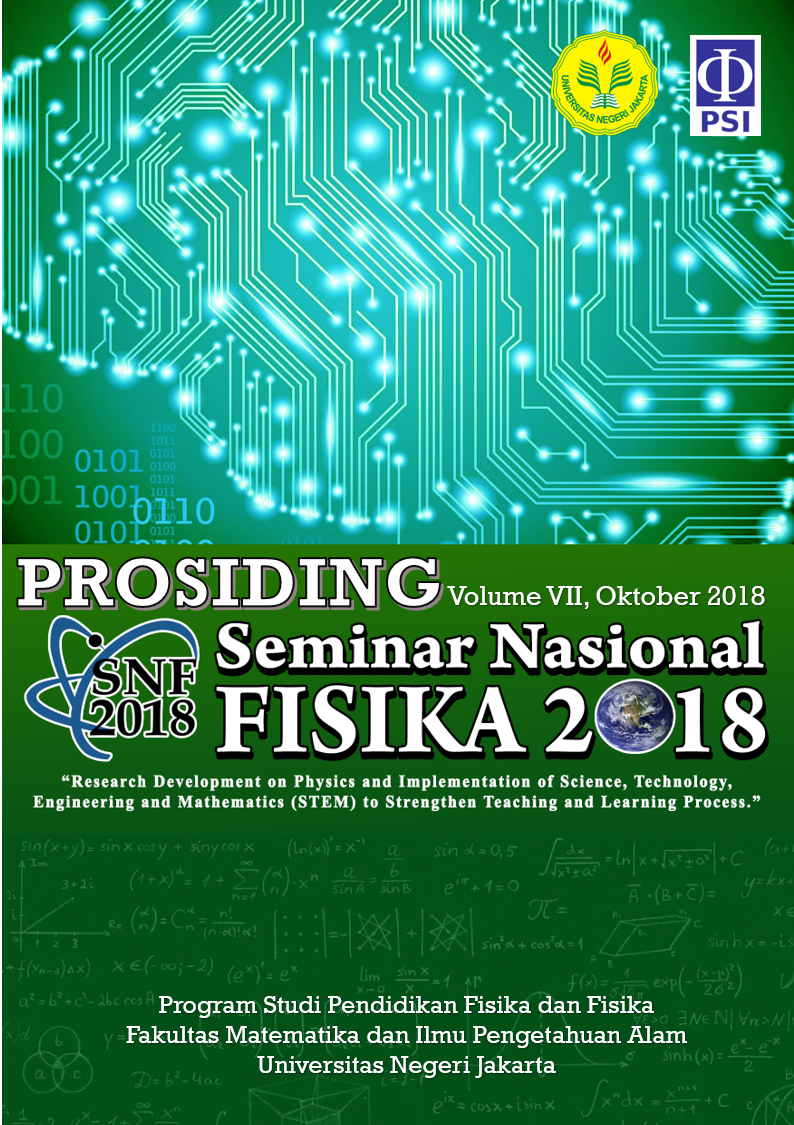STUDI KOMPOSISI DAN SIFAT OPTIK ZNO NANORODS YANG DISINTESIS MENGGUNAKAN METODE HIDROTERMAL
DOI:
https://doi.org/10.21009/03.SNF2018.02.PA.14Abstract
Abstrak
ZnO nanorods telah disintesis menggunakan teknik hidrotermal pada suhu 95 â°C selama 2 jam. Studi komposisi ZnO nanorods dilakukan menggunakan energy dispersive sinar-x (EDS). Hasil pengujian memberikan konfirmasi bahwa komposisi massa Zn lebih banyak dibandingkan komposisi massa O yaitu 69,44% dan 30,56%. Pengujian sifat optik ZnO nanorods menggunakan spektrofotometer UV-Vis memberikan informasi bahwa terdapat absorbansi tinggi di rentang panjang gelombang ultra-violet (UV) yaitu 360-390 nm. dan absorbansi yang lebar di rentang panjang gelombang cahaya tampak.
Kata-kata kunci: ZnO nanorods, komposisi, absorbansi, band gap energy
Abstract
ZnO nanorods have been synthesized by hydrothermal method at 95 °C for 2 hours. The study composition of ZnO nanorods was performed using energy dispersive x-ray (EDS). The results confirm that elemental mass compositions of Zn and O are 69,44% and 30,56%. The optical properties of ZnO nanorods which investigated by using the UV-Vis spectrophotometer confirmed that the strong absorbance is in the range of UV wavelength (360-390 nm), and wide absorbances in the wavelength range of visible light.
Keywords: ZnO nanorods, compositions, absorbance, band gap energy
References
[2] I. Sugihartono, E. Handoko, V. Fauzia, A. Arkundato, and L. P. Sari, “Structural and Photoluminescence Properties of ZnO Thin Films Deposited by Ultrasonic Spray Pyrolysis,” 2018, vol. 22, no. 1, pp. 13–16.
[3] N. A. Putri, V. Fauzia, S. Iwan, L. Roza, A. A. Umar, and S. Budi, “Mn-doping-induced photocatalytic activity enhancement of ZnO nanorods prepared on glass substrates,” Appl. Surf. Sci., 2018, vol. 439, pp. 285–297.
[4] S. Iwan, V. Fauzia, A. A. Umar, and X. W. Sun, “Room temperature photoluminescence properties of ZnO nanorods grown by hydrothermal reaction,” 2016, AIP Conf. Proc., vol. 1729, p. 020031.
[5] A. Lestari, S. Iwan, D. Djuhana, C. Imawan, A. Harmoko, and V. Fauzia, “Effect of precursor concentration on the structural and optical properties of ZnO nanorods prepared by hydrothermal method,” AIP Conf. Proc., 2016, vol. 1729, p. 020027.
[6] F. E. R., E. Budi, M. A. Marpaung, M. R. Sahar, and N. Huda, “KARAKTERISASI STRUKTUR DAN SIFAT TERMAL SISTEM KACA (70-X)P2O5-30mgo-Xzno DENGAN TEKNIK MELT QUENCHING”, SPEKTRA, vol. 1, no. 1, pp. 49 - 54, Aug. 2016.
[7] I. Permana, E. Budi, M. A. Marpaung, M. R. Sahar, and P. A. Buchori, “KARAKTERISASI SIFAT FISIK DAN ABSORPSI OPTIKAL SISTEM KACA ZnO – MgO - P2O5 MENGGUNAKAN TEKNIK MELT QUENCHING”, SPEKTRA, vol. 1, no. 1, pp. 61 - 68, Aug. 2016.
[8] M. Y. Frestika, “INVESTIGASI PEMBENTUKKAN IKATAN Zn-O RODS DI ATAS PERMUKAAN MIKROKANTILEVER DENGAN UJI KARAKTERISASI FTIR”, SPEKTRA, vol. 2, no. 2, pp. 91 - 98, Aug. 2017.
[9] T. Saragi, “KARAKTERISRIK KRISTAL DAN OPTIK NANOPARTIKEL ZINC OXIDE: KAJIAN EFEK MOLARITAS DALAM PROSES HIDROTHERMAL”, SPEKTRA, vol. 1, no. 2, pp. 137 - 142, Dec. 2016.
[10] Beiser, A, “Concepts Of Modern Physics”, 1965, American Journal of Physics. New York : Mc Graw-Hill.
[11] Shi, S., Yang, Y., Xu, J., Li, L., Zhang, X., Hu, G., & Dang, Z, “Structural, Optical and Magnetic Properties Of Co-doped ZnO Nanorods Prepared by Hydrothermal Method”, 2013, Journal Of Alloys and Compounds, Elsevier.





